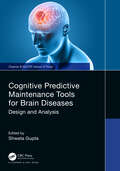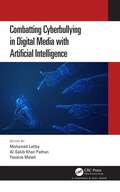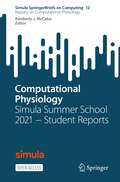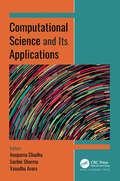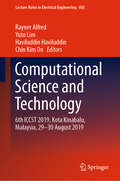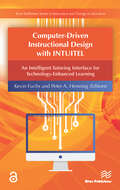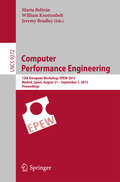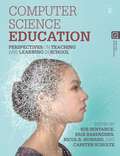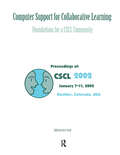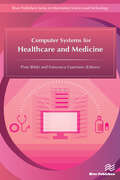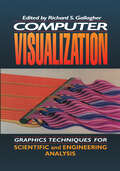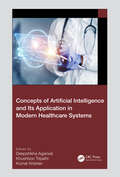- Table View
- List View
Cognitive Predictive Maintenance Tools for Brain Diseases: Design and Analysis (Chapman & Hall/CRC Internet of Things)
This book involves the design, analysis, and application of various cognitive predictive maintenance tests with the help of tools like vibration analysis, ultrasonic analysis, infrared analysis, oil analysis, laser-shaft alignment, and motor circuit analysis in the prediction of various cognitive diseases such as epilepsy, Parkinson’s disease, Alzheimer’s disease, and depression. These are needed since there are no proper medical tests available to predict these diseases in remote areas at an early stage. Various emerging technologies are analyzed for the design of tests. Key features: Incorporates innovative processes for treating cognitive diseases. Early and exact identification and treatment strategies are incorporated. Future technologies like artificial intelligence, machine learning, the IoT, and data science are used to find solutions. Analysis with existing cognitive disease solutions is incorporated and simulations provided. The novelty of the book lies in the accurate prediction of cognitive diseases. Encompassing future technologies and various communication protocols or devices available for cognitive diseases for the design of new equipment are an outcome of the book. Various parameters like power consumption, productivity, and safety should be taken into account during the analysis, design, and application of a product. The book could well be added to the curriculum of medical colleges and biomedical engineering students. Possible vendors include biomedical research centers like Biotechnika and the Indian Council of Medical Research (ICMR). It would be a breakthrough for biomedical companies to launch their new products.
Combatting Cyberbullying in Digital Media with Artificial Intelligence
Rapid advancements in mobile computing and communication technology and recent technological progress have opened up a plethora of opportunities. These advancements have expanded knowledge, facilitated global business, enhanced collaboration, and connected people through various digital media platforms. While these virtual platforms have provided new avenues for communication and self-expression, they also pose significant threats to our privacy. As a result, we must remain vigilant against the propagation of electronic violence through social networks. Cyberbullying has emerged as a particularly concerning form of online harassment and bullying, with instances of racism, terrorism, and various types of trolling becoming increasingly prevalent worldwide. Addressing the issue of cyberbullying to find effective solutions is a challenge for the web mining community, particularly within the realm of social media. In this context, artificial intelligence (AI) can serve as a valuable tool in combating the diverse manifestations of cyberbullying on the Internet and social networks. This book presents the latest cutting-edge research, theoretical methods, and novel applications in AI techniques to combat cyberbullying. Discussing new models, practical solutions, and technological advances related to detecting and analyzing cyberbullying is based on AI models and other related techniques. Furthermore, the book helps readers understand AI techniques to combat cyberbullying systematically and forthrightly, as well as future insights and the societal and technical aspects of natural language processing (NLP)-based cyberbullying research efforts. Key Features: Proposes new models, practical solutions and technological advances related to machine intelligence techniques for detecting cyberbullying across multiple social media platforms. Combines both theory and practice so that readers (beginners or experts) of this book can find both a description of the concepts and context related to the machine intelligence. Includes many case studies and applications of machine intelligence for combating cyberbullying.
Composing Model-Based Analysis Tools
This book presents joint works of members of the software engineering and formal methods communities with representatives from industry, with the goal of establishing the foundations for a common understanding of the needs for more flexibility in model-driven engineering. It is based on the Dagstuhl Seminar 19481 „Composing Model-Based Analysis Tools“, which was held November 24 to 29, 2019, at Schloss Dagstuhl, Germany, where current challenges, their background and concepts to address them were discussed. The book is structured in two parts, and organized around five fundamental core aspects of the subject: (1) the composition of languages, models and analyses; (2) the integration and orchestration of analysis tools; (3) the continual analysis of models; (4) the exploitation of results; and (5) the way to handle uncertainty in model-based developments. After a chapter on foundations and common terminology and a chapter on challenges in the field, one chapter is devoted to each of the above five core aspects in the first part of the book. These core chapters are accompanied by additional case studies in the second part of the book, in which specific tools and experiences are presented in more detail to illustrate the concepts and ideas previously introduced. The book mainly targets researchers in the fields of software engineering and formal methods as well as software engineers from industry with basic familiarity with quality properties, model-driven engineering and analysis tools. From reading the book, researchers will receive an overview of the state-of-the-art and current challenges, research directions, and recent concepts, while practitioners will be interested to learn about concrete tools and practical applications in the context of case studies.
Computational Collective Intelligence: 7th International Conference, ICCCI 2015, Madrid, Spain, September 21-23, 2015, Proceedings, Part I (Lecture Notes in Computer Science #9329)
This two-volume set (LNAI 9329 and LNAI 9330) constitutes the refereed proceedings of the 7th International Conference on Collective Intelligence, ICCCI 2014, held in Madrid, Spain, in September 2015. The 110 full papers presented were carefully reviewed and selected from 186 submissions. They are organized in topical sections such as multi-agent systems; social networks and NLP; sentiment analysis; computational intelligence and games; ontologies and information extraction; formal methods and simulation; neural networks, SMT and MIS; collective intelligence in Web systems – Web systems analysis; computational swarm intelligence; cooperative strategies for decision making and optimization; advanced networking and security technologies; IT in biomedicine; collective computational intelligence in educational context; science intelligence and data analysis; computational intelligence in financial markets; ensemble learning; big data mining and searching.
Computational Intelligence in Analytics and Information Systems: Volume 2: Advances in Digital Transformation, Selected Papers from CIAIS-2021
This new volume presents a selection of state-of-the-art technological advancements in IoT, network technologies, and software engineering that address unsolved issues in computational intelligence. The volume focuses on empirical, theoretical, and application perspectives on smart technologies and computational intelligence, identifying the advantages and limitations of each. The chapters on smart technologies address their application in communication services, healthcare and assistive technology, urban waste management, vehicle pollution and accident detection, and more. The technologies encompass the use of machine learning, blockchain, fog computing, etc. The volume goes on to discuss computational intelligence in network technologies as well as cryptography mechanisms, internet privacy protection, satellite communication technology, ant colony optimization algorithms, etc. The topics on computational intelligence in software engineering include security optimization via software-defined networking, education-based interactive automated agent, data warehouse requirement engineering, and more. Together with Volume 1: Data Science and AI, Selected Papers from CIAIS-2021, this 2-volume set offers and abundance of valuable information on emerging technologies in computational intelligence.
Computational Intelligence in Analytics and Information Systems: Volume 1: Data Science and AI, Selected Papers from CIAIS-2021
The new book presents a valuable selection of state-of-the-art technological advancements using the concepts of AI and machine learning, highlighting the use of predictive analytics of data to find timely solutions to real-time problems. It helps to identify applicable approaches in order to enhance, automate, and develop effective solutions to challenges in data science and artificial intelligence. The various novel approaches include applications in healthcare, natural language processing, and smart cities. As such, the book is divided into sections that address: Computational Intelligence in Image Processing Computational Intelligence in Healthcare Techniques for Natural Language Processing Computational Intelligence in Smart Cities The very diverse range of topics include AI and machine learning applications for In security: For using digital image processing for image fusion (face recognition, feature extraction, object detection as well tracking, moving object identification), for person re-identification for security purposes. In healthcare and medicine: For diagnosis and prediction of breast cancer, other cancers, diabetes, heart disease; for predicting susceptibility to COVID-19; for prediction of mood and anxiety disorders. In agriculture: For prediction of crop profit; for prediction of cropping patterns and recommendation for crop cultivation. In traffic science/smart cities: For understanding road scene images, for detection of traffic signs, for devising a fog-based intelligent traffic phase timing regulation system In language/speech/text: For automatic text summarization, for document indexing for unstructured data, for speech/accent recognition, for sound separation, for American Sign Language interpretation for nonsigners, for emotional recognition and analysis through speech, body postures with facial expressions, and other body movements (to improve the performance of virtual personal assistants / emotion recognition using speech, body postures with facial expressions and other body movements. This volume offers valuable information for researchers working in interdisciplinary or multidisciplinary areas of healthcare, image analysis, natural language processing, and smart cities. This includes academicians, people in industry, and students with engineering background with research interest in these areas. These peer-review chapters were selected from the International Conference on Computational Intelligence in Analytics and Information Systems (CIAIS- 2021), held in April 2021 at Manav Rachna University, India. Together with Volume 2: Advances in Digital Transformation, this 2-volume set offers an abundacne of valuable information on emerging technologies in computational intelligence in information systems focusing on data science and artificial intelliegence.
Computational Intelligence in the Industry 4.0 (Intelligent Data-Driven Systems and Artificial Intelligence)
This book discusses the importance of using industrial intelligence in collaboration with computational intelligence in forming a smart system for diverse applications. It further illustrates the challenges and deployment issues in industrial resolution. The text highlights innovation and applications of computational agents and the industrial intelligence era to automate the requirements as per Industry 4.0.This book: Discusses computational agents for handling automation issues and the role of ethics in industrial resolution Presents intelligence approaches for products, operations, systems, and services Illustrates the fundamentals of computational intelligence to forecast and analyze the requirements of society for automation as well as recent innovations and applications Highlights computation intelligence approaches in reducing human effort and automating the analysis of the production unit Showcases current innovation and applications of computational agents and industrial intelligence as per Industry 4.0 The text is primarily written for senior undergraduate and graduate students, and academic researchers in diverse fields including electrical engineering, electronics, and communication engineering, industrial engineering, manufacturing engineering and computer science, and engineering.
Computational Interaction
This book presents computational interaction as an approach to explaining and enhancing the interaction between humans and information technology. Computational interaction applies abstraction, automation, and analysis to inform our understanding of the structure of interaction and also to inform the design of the software that drives new and exciting human-computer interfaces. The methods of computational interaction allow, for example, designers to identify user interfaces that are optimal against some objective criteria. They also allow software engineers to build interactive systems that adapt their behaviour to better suit individual capacities and preferences. Embedded in an iterative design process, computational interaction has the potential to complement human strengths and provide methods for generating inspiring and elegant designs. Computational interaction does not exclude the messy and complicated behaviour of humans, rather it embraces it by, for example, using models that are sensitive to uncertainty and that capture subtle variations between individual users. It also promotes the idea that there are many aspects of interaction that can be augmented by algorithms. This book introduces computational interaction design to the reader by exploring a wide range of computational interaction techniques, strategies and methods. It explains how techniques such as optimisation, economic modelling, machine learning, control theory, formal methods, cognitive models and statistical language processing can be used to model interaction and design more expressive, efficient and versatile interaction.
Computational Physiology: Simula Summer School 2021 − Student Reports (Simula SpringerBriefs on Computing #12)
This open access volume compiles student reports from the 2021 Simula Summer School in Computational Physiology. Interested readers will find herein a number of modern approaches to modeling excitable tissue. This should provide a framework for tools available to model subcellular and tissue-level physiology across scales and scientific questions. In June through August of 2021, Simula held the seventh annual Summer School in Computational Physiology in collaboration with the University of Oslo (UiO) and the University of California, San Diego (UCSD). The course focuses on modeling excitable tissues, with a special interest in cardiac physiology and neuroscience. The majority of the school consists of group research projects conducted by Masters and PhD students from around the world, and advised by scientists at Simula, UiO and UCSD. Each group then produced a report that addreses a specific problem of importance in physiology and presents a succinct summary of the findings. Reports may not necessarily represent new scientific results; rather, they can reproduce or supplement earlier computational studies or experimental findings. Reports from eight of the summer projects are included as separate chapters. The fields represented include cardiac geometry definition (Chapter 1), electrophysiology and pharmacology (Chapters 2–5), fluid mechanics in blood vessels (Chapter 6), cardiac calcium handling and mechanics (Chapter 7), and machine learning in cardiac electrophysiology (Chapter 8).
Computational Physiology: Simula Summer School 2022 − Student Reports (Simula SpringerBriefs on Computing #13)
This open access volume compiles student reports from the 2022 Simula Summer School in Computational Physiology. The reports provide an overview of some tools available to model physiology in excitable tissues across scales and scientific questions. In 2022, Simula held the eighth annual Summer School in Computational Physiology in collaboration with the University of Oslo (UiO) and the University of California, San Diego (UCSD). Each year, the course focuses on modeling excitable tissues, with a special interest in cardiac physiology and neuroscience. Group research projects conducted by graduate students from around the world result in reports addressing problems of physiological importance. Reports may not necessarily represent new scientific results; rather, they can reproduce or supplement earlier studies.Reports from seven of the summer projects are included as separate chapters. The topics represented include multiscale mechanics, electrophysiology, pharmacology, and machine learning.
Computational Science and Its Applications
This new volume explores the overlapping behavior of some aspects of computational science, focusing on the intersection of computing hardware, algorithms, mathematics, and data management components. The chapters discuss the various application areas of the computational science techniques such as artificial intelligence, machine learning, data science, quantum computing, image processing, evolutionary algorithms, process simulation, deep learning, big data analysis, etc.
Computational Science and Technology: 6th ICCST 2019, Kota Kinabalu, Malaysia, 29-30 August 2019 (Lecture Notes in Electrical Engineering #603)
This book gathers the proceedings of the Sixth International Conference on Computational Science and Technology 2019 (ICCST2019), held in Kota Kinabalu, Malaysia, on 29–30 August 2019. The respective contributions offer practitioners and researchers a range of new computational techniques and solutions, identify emerging issues, and outline future research directions, while also showing them how to apply the latest large-scale, high-performance computational methods.
Computer Assisted Instruction and Intelligent Tutoring Systems: Shared Goals and Complementary Approaches (Technology and Education Series)
The fields of computer-assisted instruction and intelligent tutoring systems have had few vehicles for sharing ideas or programs. Different backgrounds and settings meant reading different journals and attending different conferences. The purpose of this book is to foster a mutual understanding of shared issues and contemporary approaches so as to further powerful educational applications of computing. It is unique in drawing on both the intelligent tutoring systems and computer assisted instruction communities. Each chapter provides an in-depth discussion by leaders in these fields of current work, focusing on instructional programs -- their design, use, and evaluation. The editors and authors have made extensive efforts to ensure each chapter's clarity and readability for both communities.
Computer-Driven Instructional Design with INTUITEL
INTUITEL is a research project that was co-financed by the European Commission with the aim to advance state-of-the-art e-learning systems via addition of guidance and feedback for learners. Through a combination of pedagogical knowledge, measured learning progress and a broad range of environmental and background data, INTUITEL systems will provide guidance towards an optimal learning pathway. This allows INTUITEL-enabled learning management systems to offer learners automated, personalised learning support so far only provided by human tutors INTUITEL is - in the first place - a design pattern for the creation of adaptive e-learning systems. It focuses on the reusability of existing learning material and especially the annotation with semantic meta data. INTUITEL introduces a novel approach that describes learning material as well as didactic and pedagogical meta knowledge by the use of ontologies. Learning recommendations are inferred from these ontologies during runtime. This way INTUITEL solves a common problem in the field of adaptive systems: it is not restricted to a certain field. Any content from any domain can be annotated. The INTUITEL research team also developed a prototype system. Both the theoretical foundations and how to implement your own INTUITEL system are discussed in this book.
Computer Performance Engineering: 12th European Workshop, EPEW 2015, Madrid, Spain, August 31 - September 1, 2015, Proceedings (Lecture Notes in Computer Science #9272)
This book constitutes the refereed proceedings of the 12th European Workshop on Computer Performance Engineering, EPEW 2015, held in Madrid, Spain, in August/September 2015. The 19 papers presented in this volume were carefully reviewed and selected from 39 submissions. They were organized in topical sections named: applications; modelling techniques, software performance, and simulation techniques.
Computer Science Education: Perspectives on Teaching and Learning in School
Drawing together the most up-to-date research from experts all across the world, the second edition of Computer Science Education offers the most up-to-date coverage available on this developing subject, ideal for building confidence of new pre-service and in-service educators teaching a new discipline. It provides an international overview of key concepts, pedagogical approaches and assessment practices. Highlights of the second edition include:- New sections on machine learning and data-driven (epistemic) programming- A new focus on equity and inclusion in computer science education- Chapters updated throughout, including a revised chapter on relating ethical and societal aspects to knowledge-rich aspects of computer science education- A new set of chapters on the learning of programming, including design, pedagogy and misconceptions- A chapter on the way we use language in the computer science classroom. The book is structured to support the reader with chapter outlines, synopses and key points. Explanations of key concepts, real-life examples and reflective points keep the theory grounded in classroom practice. The book is accompanied by a companion website, including online summaries for each chapter, 3-minute video summaries by each author and an archived chapter on taxonomies and competencies from the first edition.
Computer Support for Collaborative Learning: Foundations for A Cscl Community (cscl 2002 Proceedings)
Computer Support for Collaborative Learning (CSCL) is a field of study centrally concerned with meaning and the practices of meaning-making in the context of joint activity, and the ways in which these practices are mediated through designed artifacts. This volume includes abstracts of papers that were presented during interactive poster sessions at CSCL 2002. Documenting an extremely heterogeneous, productive phase of inquiry with broad social consequences, these proceedings reflect the current state of CSCL research--particularly in North America and Western Europe.
Computer Systems for Healthcare and Medicine
The development of modern civilization leads to us having to solve new problems which did not exist before. The contemporary world faces a great challenge of aging societies, where the increasing number of citizens requires constant medical attention. To ensure safety and wellbeing of elderly people, patients in hospitals and disabled persons, advanced technologies can be implemented. These include both sophisticated data acquisition systems and data processing algorithms, aiming at the constant and discreet monitoring of persons whilst raising alarm if immediate attention is required.Computer Systems for Healthcare and Medicine presents a novel look at the introduced problems, including proposed solutions in the form of automated data acquisition and processing systems, which were tested in various environments. Characteristic features include a wide range of sensors used to monitor the situation of the person, and accurate decision making algorithms, often based on the computational intelligence domain. Technical topics discussed in the book include application for the healthcare of the following:Infrared sensorsMEMSUltra wideband radarsDeep learningDecision treesArtificial neural networksGabor filtersDecision support systems
Computer Vision: Challenges, Trends, and Opportunities (Chapman & Hall/CRC Computer Vision)
Computer vision has made enormous progress in recent years, and its applications are multifaceted and growing quickly, while many challenges still remain. This book brings together a range of leading researchers to examine a wide variety of research directions, challenges, and prospects for computer vision and its applications.This book highlights various core challenges as well as solutions by leading researchers in the field. It covers such important topics as data-driven AI, biometrics, digital forensics, healthcare, robotics, entertainment and XR, autonomous driving, sports analytics, and neuromorphic computing, covering both academic and industry R&D perspectives. Providing a mix of breadth and depth, this book will have an impact across the fields of computer vision, imaging, and AI.Computer Vision: Challenges, Trends, and Opportunities covers timely and important aspects of computer vision and its applications, highlighting the challenges ahead and providing a range of perspectives from top researchers around the world. A substantial compilation of ideas and state-of-the-art solutions, it will be of great benefit to students, researchers, and industry practitioners.
Computer Visualization: Graphics Techniques for Engineering and Scientific Analysis
Rapid advances in 3-D scientific visualization have made a major impact on the display of behavior. The use of 3-D has become a key component of both academic research and commercial product development in the field of engineering design. Computer Visualization presents a unified collection of computer graphics techniques for the scientific visualization of behavior. The book combines a basic overview of the fundamentals of computer graphics with a practitioner-oriented review of the latest 3-D graphics display and visualization techniques. Each chapter is written by well-known experts in the field. The first section reviews how computer graphics visualization techniques have evolved to work with digital numerical analysis methods. The fundamentals of computer graphics that apply to the visualization of analysis data are also introduced. The second section presents a detailed discussion of the algorithms and techniques used to visualize behavior in 3-D, as static, interactive, or animated imagery. It discusses the mathematics of engineering data for visualization, as well as providing the current methods used for the display of scalar, vector, and tensor fields. It also examines the more general issues of visualizing a continuum volume field and animating the dimensions of time and motion in a state of behavior. The final section focuses on production visualization capabilities, including the practical computational aspects of visualization such as user interfaces, database architecture, and interaction with a model. The book concludes with an outline of successful practical applications of visualization, and future trends in scientific visualization.
Concepts of Artificial Intelligence and its Application in Modern Healthcare Systems
This reference text presents the usage of artificial intelligence in healthcare and discusses the challenges and solutions of using advanced techniques like wearable technologies and image processing in the sector. Features: Focuses on the use of artificial intelligence (AI) in healthcare with issues, applications, and prospects Presents the application of artificial intelligence in medical imaging, fractionalization of early lung tumour detection using a low intricacy approach, etc. Discusses an artificial intelligence perspective on wearable technology Analyses cardiac dynamics and assessment of arrhythmia by classifying heartbeat using electrocardiogram (ECG) Elaborates machine learning models for early diagnosis of depressive mental affliction This book serves as a reference for students and researchers analyzing healthcare data. It can also be used by graduate and post graduate students as an elective course.
Connected Health in Smart Cities
This book reports on the theoretical foundations, fundamental applications and latest advances in various aspects of connected services for health information systems.The twelve chapters highlight state-of-the-art approaches, methodologies and systems for the design, development, deployment and innovative use of multisensory systems and tools for health management in smart city ecosystems. They exploit technologies like deep learning, artificial intelligence, augmented and virtual reality, cyber physical systems and sensor networks.Presenting the latest developments, identifying remaining challenges, and outlining future research directions for sensing, computing, communications and security aspects of connected health systems, the book will mainly appeal to academic and industrial researchers in the areas of health information systems, smart cities, and augmented reality.
Conquering JavaScript: D3.js (Conquering JavaScript)
JavaScript has become the de facto standard when it comes to both web and cross-platform development. D3.js is an extremely popular JS framework, meant for rapid web and application development. Conquering JavaScript: D3.js helps the reader master the D3.js framework for faster and more robust development. This book is a detailed guide that will help developers and coders do more with D3.js. It discusses the basics in brief, and then moves on to more advanced and detailed exercises to help readers quickly gain the required knowledge. Key Features: Provides industry-specific case-based examples. Discusses visual implementation of D3.js for project work. Emphasizes how to write clean and maintainable code. This book is a valuable reference for D3.js developers as well as those involved in game development, mobile apps, progressive applications, and now even desktop apps.
Conquering JavaScript: Node.js (Conquering JavaScript)
JavaScript is without a question among the most prominent and commonly used client-side programming languages available. JavaScript's scope of use has expanded in recent years, and it is now also used for server-side development. Node.js is an extremely popular JS framework, meant for rapid web and application development. Conquering JavaScript: Node.js helps the reader master the Node.js framework for faster and more robust development. This book is a detailed guide that will help developers and coders do more with Node.js. It discusses the basics in brief, and then moves on to more advanced and detailed exercises to help readers quickly gain the required knowledge. Key Features: Discusses how to use Node.js for real-world practical solutions Provides complete coverage of full-stack development Covers server-side development with Node.js This book is a valuable reference for Node.js developers as well as those involved in game development, mobile apps, progressive applications, and now even desktop apps.
Conquering JavaScript: Three.js (Conquering JavaScript)
Have you ever considered how these visuals and games are shown in a web browser? What technology is at the heart of it? Of course, employing HTML and CSS alone will not be sufficient. Three.js is a free JavaScript toolkit for displaying images, 3D, and 2D objects in web browsers that enables you to render graphics and 3D objects on a canvas in the web browser using your GPU (Graphics Processing Unit). Conquering JavaScript: Three.js helps the reader master the Three.js framework for faster and robust development. The book is a detailed guide that will help developers and coders do more with Three.js. It covers the basics in brief, and then moves on to more advanced and detailed exercises to help readers quickly gain the required knowledge. Key Features: Examines JavaScript specific content, with emphasis on graphics libraries Discusses using Three.js for animated graphic creation Provides code optimization tips and solutions This book is a valuable reference for Three.js developers as well as those involved in game development, mobile apps, progressive applications, and now even desktop apps.
